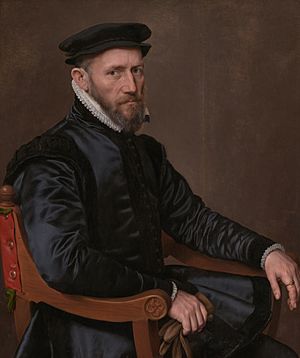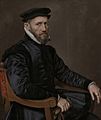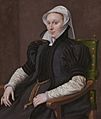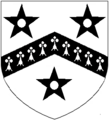Thomas Gresham facts for kids
Quick facts for kids
Thomas Gresham
|
|
|---|---|

Portrait of Thomas Gresham, aged 26, displaying his merchant's mark (left), marking his marriage in 1544 to Dame Anne Read (née Ferneley). From the collection of the Mercers' Company, City of London.
|
|
| Born |
Thomas Gresham the Elder
c. 1519 London, England
|
| Died | 21 November 1579 (aged 59–60) London, England
|
| Resting place | St Helen's Church, Bishopsgate, London, England |
| Nationality | British |
| Occupation | Merchant, financier |
| Known for | Founder of The Royal Exchange and Gresham College |
Sir Thomas Gresham (born around 1519 – died 21 November 1579) was an important English merchant and financier. He worked for King Edward VI (1547–1553) and his half-sisters, Queen Mary I (1553–1558) and Queen Elizabeth I (1558–1603). In 1565, Gresham started the Royal Exchange in the City of London.
Contents
Early Life and Family
Thomas Gresham was born in London. His family came from Norfolk. He was one of four children of Sir Richard Gresham. His father was a successful merchant and once served as Lord Mayor of London. King Henry VIII knighted Sir Richard for arranging good loans with merchants from other countries.
Education and Training
Thomas Gresham went to St Paul's School. Even though his father wanted him to be a merchant, he first sent Thomas to Gonville and Caius College, Cambridge at Cambridge.
While at university, Thomas also trained with his uncle, Sir John Gresham. His uncle was a member of the Mercers' Company and founded Gresham's School. This training helped Thomas learn about trade and business.
Working in the Low Countries
In 1543, when he was 24, Gresham became a full member of the Mercers' Company. Later that year, he moved to the Low Countries (an area that includes modern-day Belgium and the Netherlands).
There, he worked as a merchant. He also acted as an agent for King Henry VIII. In 1544, he married Anne Ferneley. She was the widow of a London merchant. Gresham mainly lived in Antwerp, which is now in Belgium. He became well-known for his clever business skills there.
Smart Financial Moves
Helping the English Economy
In 1551, the English government was having money problems. This was because of poor management by another merchant. The government asked Gresham for help. They followed his ideas, which were very clever.
Gresham found ways to increase the value of the pound sterling (English money) on the Antwerp stock exchange. His plans worked so well that King Edward VI paid off almost all his debts in just a few years. The government often asked Gresham for advice on money matters. They also sent him on important diplomatic trips. He didn't have a fixed salary. Instead, King Edward gave him land as a reward. These lands were worth about 400 pounds a year.
Working for Later Monarchs
When Queen Mary became queen in 1553, Gresham lost his favored position for a short time. But the person who replaced him wasn't successful. So, Gresham was soon brought back. He promised to serve the Queen well. He was very good at arranging loans and secretly moving money, weapons, and goods. Because of this, he kept his job throughout her reign (1553–1558). He also received more land worth 200 pounds a year.
Under Queen Elizabeth (1558–1603), Gresham continued to be the Crown's financial agent. He also served as an ambassador to the court of Duchess Margaret of Parma, who governed the Netherlands. He was made a Knight Bachelor in 1559 before he left.
He had to leave Antwerp in 1567 because of unrest there. But even though he spent the rest of his life in London, he continued his work as a merchant and government agent. Queen Elizabeth also used Gresham's skills in other ways. For example, she made him the gaoler (jailer) for Lady Mary Grey. Lady Mary was imprisoned in Gresham's house from 1569 to 1572.
Starting the Royal Exchange
In 1565, Gresham suggested building a new trading place in London. This place would be called the Royal Exchange. He offered to pay for it himself. But he asked the City of London to provide a good location.
Gresham was also smart about his own money. He earned about £700 a year from renting out shops in the upper part of the building. This gave him more than enough money to cover his costs.
The Royal Exchange was based on the stock exchange in Antwerp. It became a very important place for merchants in London.
Marriage and Family
In 1544, Thomas Gresham married Anne Ferneley. She was the widow of a London merchant. They had one son, who sadly died before Gresham did. Gresham also had a daughter outside of marriage. She later married Sir Nathaniel Bacon.
Death and Burial
Thomas Gresham died suddenly on 21 November 1579. He was buried at St Helen's Church, Bishopsgate in the City of London.
Gresham College
In his will, Gresham left most of his money and properties to his wife. After her death, his house in Bishopsgate Street and the money from the Royal Exchange were to go to the City of London and the Mercers Company.
This money was used to start a college. Seven professors would teach lectures there, one each day of the week. They would teach subjects like astronomy, geometry, medicine, law, religion, rhetoric (the art of speaking well), and music. This is how Gresham College was founded in 1597. It was the first place for higher education in London.
Gresham's Law
You might hear of "Gresham's Law." It's a simple idea: "Bad money drives out good." This means that if there are two types of money with the same value, people will spend the "bad" (less valuable) money and save the "good" (more valuable) money.
The law is named after Gresham because he told Queen Elizabeth to fix England's money. However, Thomas Gresham himself never actually wrote down this "law." It was named after him much later, in 1857, by an economist named Henry Dunning Macleod.
The Gresham Grasshopper
The Gresham family has a special symbol called a crest. It's a golden grasshopper on a green mound. You can see this grasshopper at Gresham College, which he founded. It's also the weathervane on top of the Royal Exchange.
There's an old story that the first person in the Gresham family was a baby found in long grass in the 1200s. A grasshopper supposedly drew attention to the child. But it's more likely that the grasshopper symbol is just a clever play on the sound of "Gresh-" and "grassh-." The Gresham family's motto is Fiat Voluntas Tua, which means 'Thy will be done'.
Legacy
- The Royal Exchange, which he founded in 1565, opened in 1571.
- Gresham College, funded by his will, opened in 1597.
- Gresham Street in the City of London is named after him. It runs near St Paul's Cathedral and the Bank of England.
- The Gresham Palace in Budapest is named after him.
- The Gresham Club in the City was also named in his honor.
- The Gresham Hotel, Dublin is also linked to his name. It was started in 1817 by another Thomas Gresham. This later Thomas Gresham was given the name because he was a foundling left on the steps of the Royal Exchange.
- Gresham Road is near Gresham's old home at Osterley Park in Hounslow.
Images for kids
-
Gresham's bust at
Stowe School -
Gresham's initials "TG" and date 1563 with his golden grasshopper emblem, serving as the sign of a bank in Lombard Street, the historic centre of banking in the City of London
-
Sir Thomas Gresham, portrait c. 1554 by Anthonis Mor
-
Dame Anne née Ferneley, wife of Sir Thomas Gresham. Portrait c. 1560 by Anthonis Mor
-
Sir Thomas Gresham's merchant's mark as depicted in the 1544 portrait of him owned by the Mercers' Company. Also as illustrated in Elmhirst, 1959, with more pronounced "heart shape", used by other marks of this type, e.g. the later HEICS mark
See also
 In Spanish: Thomas Gresham para niños
In Spanish: Thomas Gresham para niños
- List of multiple discoveries
- Titsey Place










